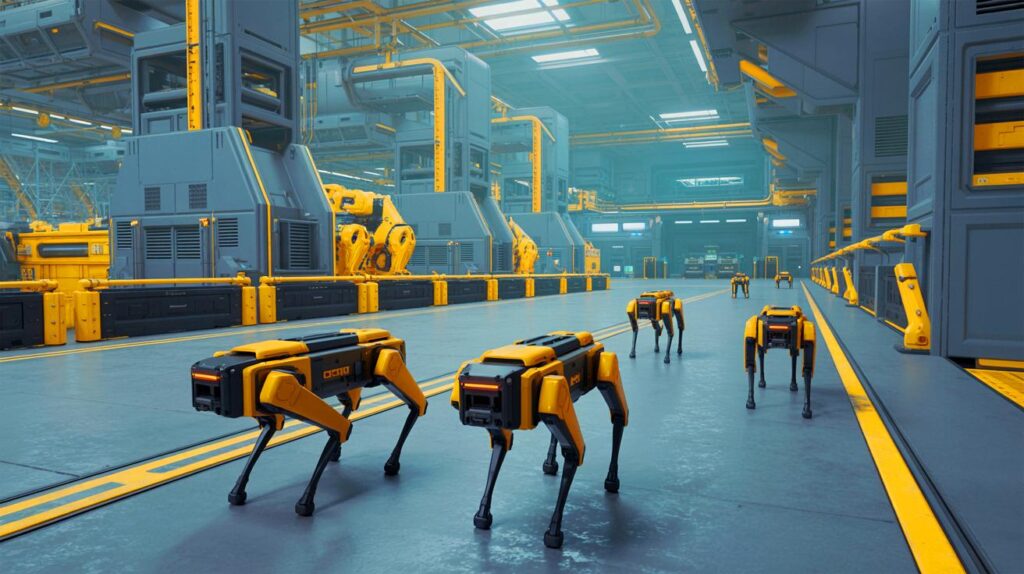The term “robot dogs in military” might have once sounded like something from a science fiction movie. But in 2025, these four legged machines are walking among us not as toys, but as sophisticated tools in both defense and industrial sectors. Their rise represents one of the most fascinating and at times alarming developments in robotics, blending artificial intelligence with real world application in ways we’ve never seen before.
How Robot Dogs in Military are Changing Defense Operations
Military forces across the globe have started deploying robot dogs in military environments for tasks ranging from surveillance to threat neutralization. These machines are designed to traverse rough terrain, carry equipment, and gather intelligence all while reducing human exposure to dangerous situations.
Ghost Robotics & U.S. Air Force
At Tyndall Air Force Base, Ghost Robotics’ Vision 60 robot dogs are actively used for perimeter security. Equipped with night vision, 360° cameras, and real time communication systems, these robot dogs can patrol remote areas that are too risky or inefficient for human soldiers.
Major Kyle McGill, part of the U.S. Air Force Robotics Task Force, says, “Deploying robot dogs has allowed us to monitor vast perimeters with precision and without fatigue. It’s like having an extra set of highly trained eyes 24/7.”
Factory Floors Go Futuristic with Robot Dogs
Beyond the battlefield, robot dogs in industry are becoming essential for maintenance, inspection, and safety enforcement. Companies like Ford, Hyundai, and Shell have started using robot dogs to reduce manual labor and prevent human injuries in hazardous zones.
Ford deployed robot dogs in their Michigan assembly plant to scan and map facility areas using LiDAR. These scans helped optimize plant layouts without interrupting ongoing operations. According to Ford’s engineering team, robot dogs increased efficiency by 30% and reduced rework time by 20%.
Key Features That Make Robot Dogs Ideal for Military and Industry
1. Autonomous Navigation Robot dogs can traverse staircases, tunnels, and rocky terrain with ease.
2. Real time Communication They transmit data instantly, enabling command centers to make informed decisions.
3. Payload Versatility They can carry cameras, sensors, weapons, or tools, depending on the mission.
4. Remote Operation Soldiers and engineers can control them from safe distances.
5. Durability Built to withstand extreme weather, water, and impact.
These features make robot dogs in military and industrial roles uniquely valuable.
Boots on the Ground with Mechanical Companions
Sgt. Miguel Torres, a communications officer in Arizona, shared, “During a mock exercise in the Mojave Desert, our robot dog identified a hidden heat signature 200 meters away. That kind of detection ability could save lives in real combat.”
Maria Ishikawa, a plant safety manager at a Japanese electronics factory, says, “We had repeated gas leak incidents in a tight underground pipeline. Since deploying our robot dog, we’ve had zero exposure related injuries. It’s become a trusted member of our team.”
These real world interactions highlight how robot dogs go beyond automation they become reliable coworkers.
Expert Opinions on Robot Dogs in Military and Beyond
While some experts celebrate the innovation, others warn of ethical and regulatory gaps. Dr. Emma Caldwell, AI ethicist from Stanford, explains, “Robot dogs in military settings blur the line between human command and machine autonomy. We need international policies before these tools become widely weaponized.”
Conversely, Dr. Lars Niemann, a robotics engineer at MIT, argues, “Used responsibly, these robots enhance safety and efficiency. The benefits outweigh the fears especially if paired with human oversight.” This balance between utility and ethics will shape the trajectory of these technologies.
Global Trends: Who’s Leading the Robot Dog Race?
1. United States Through Boston Dynamics and Ghost Robotics, the U.S. is pioneering robot dogs in military and security.
2. China Companies like Weilan are testing robot dogs for urban policing and riot control.
3. South Korea Hyundai is integrating robot dogs in smart factories.
4. Europe German and French military agencies are conducting joint trials for battlefield applications.
With every continent experimenting with robot dogs, it’s clear we’re witnessing a robotics revolution.
Challenges and Concerns Moving Forward
Despite their growing usefulness, deploying robot dogs in military and industry brings new challenges:
Hacking Risks: Robot dogs connected to networks could be vulnerable to cyberattacks.
Weaponization: Arming them raises moral and legal questions about autonomous killing machines.
Job Displacement: Human roles in inspections and patrols could shrink, creating economic disruptions.
Governments and tech firms must address these challenges through responsible design, legislation, and public engagement.
Robot Dogs in Military and Industry Are Here to Stay
The rise of robot dogs in military and industrial sectors is not a temporary trend it’s a pivotal shift in how we think about safety, efficiency, and automation. From patrolling enemy territory to inspecting gas pipelines, these robots are proving to be more than machines they’re shaping the future of work and warfare.
While the path forward must be tread carefully, one thing is certain, robot dogs are no longer toys. They are tools, partners, and in many cases, protectors.

